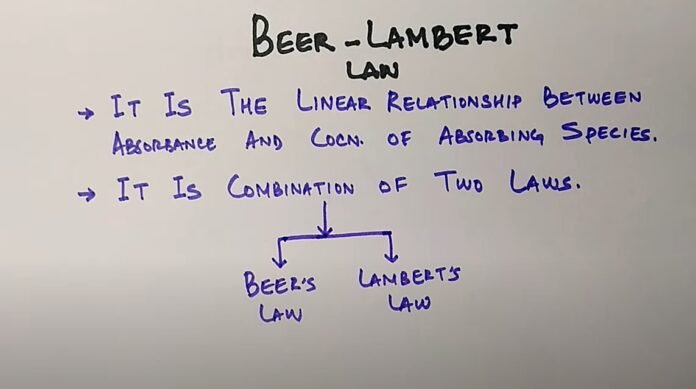We may specify the link between the strength of visible UV light and the precise amount of substance present using the Beer-Lambert Law derivation. Modern science uses the Beer-Lambert Law’s derivation extensively. used in modern laboratories for organic chemistry, drug testing, and quantification tests. These are some of the areas where this law is used.
Statement
The Beer Lambert law states that “ for a given material sample path length and concentration of the sample are directly proportional to the absorbance of the light.”
This law is expressed, mathematically as
here, represents the amount of light absorbed by the sample for a particular wavelength
represents coefficient of molar extinction
represents distance through solution covered by the light
represents the concentration of the absorbing species
Beer’s Law
Beer’s law, which asserts that concentration and absorbance are directly proportional to one another, was put out by August Beer.
Law of Lambert
Johann Heinrich Lambert stated Lambert law. It states that absorbance and path length are directly proportional.
Mathematical Formula for Beer Lambert’s Law
Formula for Beer Lambert’s law is given as
Here, is the intensity
is the initial intensity
represents the coefficient of absorption
represents the depth in meters
Derivation
Light is also absorbed when energy is absorbed, typically by electrons. In this process, several types of light, including visible and ultraviolet light, are absorbed. As a result, when light intensity changes as a result of absorption, interference, and scattering, the following results:
To get our final derivative equation, we need to solve the following equations. The percentage of light that passes through a substance is used to calculate transmittance. It is determinable as We can use the following formulas to determine the transmittance percentage:
The amount of light absorbed is what is known as absorbance, which is another important statistic. This is frequently determined as the opposite of transmittance and is represented by:
Directly proportional to the intensity of the incident light is the rate at which light intensity decreases as a function of material thickness. It has the following mathematical expression:
is directly proportional to and this can be written as
with equal to the proportionality constant
Using the equation reciprocal, we obtain,
Integrating the aforementioned equation also yields,
It stands for the intensity transmitted at the thickness and C is the integration constant in the equation above.
If we put, so we get
lf we put the value of ‘C’, we will get,
If we convert this equation in the terms of ,
After rearranging the equation, we will get,
As a result, Lambert’s law was developed, which states that when monochromatic radiation goes through a medium of uniform thickness, it changes exponentially and diminishes.
Thus, the Beer-Lambert law’s derivation is complete. This demonstrates that several distinct equations must be discovered in order to arrive at the final answer before one can deduce a particular law.
Recommended Articles:
Davisson Germer Experiment: History, Set up, Observations, And Relation
Dc Generator: Introduction, Parts, Work, Equation, Losses, Types, & Applications
Read All About Density of Air
Dependence Of Potential Difference Across A Resistor On Current With Graph
Derivation Of Amplitude Modulation: Introduction, Index, Types, Advantage, And Disadvantage
Since it is the ratio of the amount of light that enters a solution to the amount that passes through it, the term "absorbance" lacks a unit. There are occasions when absorbance is stated in "absorbance units," which are dimensionless and are denoted by the abbreviation AU. The limitations of Beer- Lambert law are mentioned below: The solution is diluted. Beer-law Lambert's describes a linear relationship between the absorbance and the concentration of an absorbing species in absorption spectroscopy. The states imply that molecule type and concentration are both important. Beer's law states that concentration and absorbance are directly proportional to one another. Derivation of Beer Lambert Law FAQs
Why is the absorbance unitless? Explain.
Enlist the limitations of Beer-Lambert’s Law.
The light beam shouldn't be dispersed at all.
Use should be made of monochromatic electromagnetic radiation.Explain absorption spectroscopy for Beer Lambert’s Law.
State the Beer’s law.
